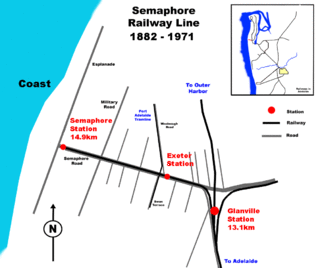
Electrical telegraphs were point-to-point text messaging systems, primarily used from the 1840s until the late 20th century. It was the first electrical telecommunications system and the most widely used of a number of early messaging systems called telegraphs, that were devised to communicate text messages quicker than physical transportation. Electrical telegraphy can be considered to be the first example of electrical engineering.
A signal is any variation of a medium that conveys information.

Telegraphy is the long-distance transmission of messages where the sender uses symbolic codes, known to the recipient, rather than a physical exchange of an object bearing the message. Thus flag semaphore is a method of telegraphy, whereas pigeon post is not. Ancient signalling systems, although sometimes quite extensive and sophisticated as in China, were generally not capable of transmitting arbitrary text messages. Possible messages were fixed and predetermined and such systems are thus not true telegraphs.

A message is a discrete unit of communication intended by the source for consumption by some recipient or group of recipients. A message may be delivered by various means, including courier, telegraphy, carrier pigeon and electronic bus. A message can be the content of a broadcast. An interactive exchange of messages forms a conversation.

An optical telegraph is a line of stations, typically towers, for the purpose of conveying textual information by means of visual signals. There are two main types of such systems; the semaphore telegraph which uses pivoted indicator arms and conveys information according to the direction the indicators point, and the shutter telegraph which uses panels that can be rotated to block or pass the light from the sky behind to convey information.

Optical communication, also known as optical telecommunication, is communication at a distance using light to carry information. It can be performed visually or by using electronic devices. The earliest basic forms of optical communication date back several millennia, while the earliest electrical device created to do so was the photophone, invented in 1880.

A railway signal is a visual display device that conveys instructions or provides warning of instructions regarding the driver's authority to proceed. The driver interprets the signal's indication and acts accordingly. Typically, a signal might inform the driver of the speed at which the train may safely proceed or it may instruct the driver to stop.

Adelaide railway station is the central terminus of the Adelaide Metro railway system. All lines approach the station from the west, and it is a terminal station with no through lines, with most of the traffic on the metropolitan network either departing or terminating here. It has nine below-ground platforms, all using broad gauge track. The station is located on the north side of North Terrace, west of Parliament House.
Flag signals can mean any of various methods of using flags or pennants to send signals. Flags may have individual significance as signals, or two or more flags may be manipulated so that their relative positions convey symbols. Flag signals allowed communication at a distance before the invention of radio and are still used especially in connection with ships.

The rail network in Adelaide, South Australia, consists of four lines and 89 stations, totalling 132 km (82 mi). It is operated by Keolis Downer under contract from the Government of South Australia, and is part of the citywide Adelaide Metro public transport system.
Secure communication is when two entities are communicating and do not want a third party to listen in. For this to be the case, the entities need to communicate in a way that is unsusceptible to eavesdropping or interception. Secure communication includes means by which people can share information with varying degrees of certainty that third parties cannot intercept what is said. Other than spoken face-to-face communication with no possible eavesdropper, it is probable that no communication is guaranteed to be secure in this sense, although practical obstacles such as legislation, resources, technical issues, and the sheer volume of communication serve to limit surveillance.
Australian railway signalling varies between the States of Australia, because the individual States are responsible for the railway systems within their own borders, with, historically, no need to co-ordinate between states except at the boundaries.

Semaphore is a northwestern suburb of Adelaide in the Australian state of South Australia. It is located on the Gulf St Vincent coastline of the Lefevre Peninsula about 14 kilometres (8.7 mi) from the Adelaide city centre.

The State Transport Authority (STA) was the government agency which controlled public transport in South Australia between 1974 and 1994.

Flag semaphore is a semaphore system conveying information at a distance by means of visual signals with hand-held flags, rods, disks, paddles, or occasionally bare or gloved hands. Information is encoded by the position of the flags; it is read when the flag is in a fixed position. Semaphores were adopted and widely used in the maritime world in the 19th century. It is still used during underway replenishment at sea and is acceptable for emergency communication in daylight or using lighted wands instead of flags, at night.

Railway semaphore signal is one of the earliest forms of fixed railway signals. This semaphore system involves signals that display their different indications to train drivers by changing the angle of inclination of a pivoted 'arm'. Semaphore signals were patented in the early 1840s by Joseph James Stevens, and soon became the most widely used form of mechanical signal. Designs have altered over the intervening years, and colour light signals have replaced semaphore signals in most countries, but in a few they remain in use.

Semaphore railway line was a railway line in the Australian state of South Australia located in the north-west of Adelaide servicing the suburbs of Semaphore and Exeter. It had two stations: Semaphore and Exeter. The line opened in 1878 and closed in 1978.

Australia was a relatively early adopter of electrical telegraph technology in the middle of the nineteenth century, despite its low population densities and the difficult conditions sometimes encountered in laying lines. From 1858 onwards, the major capitals were progressively linked, culminating in the addition of Perth in 1877. Australia was linked to the rest of the world for the first time in 1872, through the Overland Telegraph which ran some 3,200 kilometres (2,000 mi) from Adelaide through to Darwin. The network continued to expand in size and sophistication until 1959 and in heavy usage until 1945, after which time telephone usage began to erode public patronage of telegraphy services. The final publicly provided telegraphy service was closed in 1993.

The Prussian Semaphore System was a telegraphic communications system used between Berlin and the Rhine Province from 1832 to 1849. It could transmit administrative and military messages by optical signal over a distance of nearly 550 kilometres (340 mi). The telegraph line comprised 62 stations each furnished with a signal mast with six cable-operated arms. The stations were equipped with telescopes that operators used to copy coded messages and forward them to the next station. Three dispatch departments located in Berlin, Cologne and Koblenz handled the coding and decoding of official telegrams. Although electric telegraphy made the system obsolete for military use, simplified semaphores were still used for railway signals.

Semaphore is the use of an apparatus to create a visual signal transmitted over distance. A semaphore can be performed with devices including: fire, lights, flags, sunlight, and moving arms. Semaphores can be used for telegraphy when arranged in visually connected networks, or for traffic signalling such as in railway systems, or traffic lights in cities.














